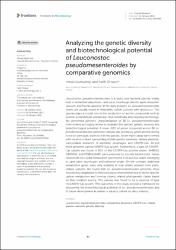| dc.contributor.author | Gumustop, Ismail | |
| dc.contributor.author | Ortakci, Fatih | |
| dc.date.accessioned | 2024-04-03T07:34:34Z | |
| dc.date.available | 2024-04-03T07:34:34Z | |
| dc.date.issued | 2023 | en_US |
| dc.identifier.issn | 1664-302X | |
| dc.identifier.uri | https://doi.org/10.3389/fmicb.2022.1074366 | |
| dc.identifier.uri | https://hdl.handle.net/20.500.12573/2075 | |
| dc.description.abstract | Leuconostoc pseudomesenteroides is a lactic acid bacteria species widely exist in fermented dairy foods, cane juice, sourdough, kimchi, apple dumpster, caecum, and human adenoid. In the dairy industry, Ln. pseudomesenteroides strains are usually found in mesophilic starter cultures with lactococci. This species plays a crucial role in the production of aroma compounds such as acetoin, acetaldehyde, and diacetyl, thus beneficially affecting dairy technology. We performed genomic characterization of 38 Ln. pseudomesenteroides from diverse ecological niches to evaluate this species’ genetic diversity and biotechnological potential. A mere ~12% of genes conserved across 38 Ln. pseudomesenteroides genomes indicate that accessory genes are the driving force for genotypic distinction in this species. Seven main clades were formed with variable content surrounding mobile genetic elements, namely plasmids, transposable elements, IS elements, prophages, and CRISPR-Cas. All but three genomes carried CRISPR-Cas system. Furthermore, a type IIA CRISPR-Cas system was found in 80% of the CRISPR-Cas positive strains. AMBR10, CBA3630, and MGBC116435 were predicted to encode bacteriocins. Genes responsible for citrate metabolism were found in all but five strains belonging to cane juice, sourdough, and unknown origin. On the contrary, arabinose metabolism genes were only available in nine strains isolated from plant-related systems. We found that Ln. pseudomesenteroides genomes show evolutionary adaptation to their ecological environment due to niche-specific carbon metabolism and forming closely related phylogenetic clades based on their isolation source. This species was found to be a reservoir of type IIA CRISPR-Cas system. The outcomes of this study provide a framework for uncovering the biotechnological potential of Ln. pseudomesenteroides and its future development as starter or adjunct culture for dairy industry. | en_US |
| dc.language.iso | eng | en_US |
| dc.publisher | Frontiers Media S.A. | en_US |
| dc.relation.isversionof | 10.3389/fmicb.2022.1074366 | en_US |
| dc.rights | info:eu-repo/semantics/openAccess | en_US |
| dc.subject | Leuconostoc pseudomesenteroides | en_US |
| dc.subject | comparative genomics | en_US |
| dc.subject | CRISPR-Cas | en_US |
| dc.subject | mobile genetic elements | en_US |
| dc.subject | genetic diversity | en_US |
| dc.title | Analyzing the genetic diversity and biotechnological potential of Leuconostoc pseudomesenteroides by comparative genomics | en_US |
| dc.type | article | en_US |
| dc.contributor.department | AGÜ, Yaşam ve Doğa Bilimleri Fakültesi, Biyomühendislik Bölümü | en_US |
| dc.contributor.authorID | 0000-0003-1319-0854 | en_US |
| dc.contributor.institutionauthor | Gumustop, Ismail | |
| dc.contributor.institutionauthor | Ortakci, Fatih | |
| dc.identifier.volume | 13 | en_US |
| dc.identifier.startpage | 1 | en_US |
| dc.identifier.endpage | 19 | en_US |
| dc.relation.journal | Frontiers in Microbiology | en_US |
| dc.relation.publicationcategory | Makale - Uluslararası Hakemli Dergi - Kurum Öğretim Elemanı | en_US |


















